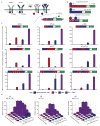Multiplexing Engineered Receptors for Multiparametric Evaluation of Environmental Ligands
- PMID: 28771312
- PMCID: PMC5693605
- DOI: 10.1021/acssynbio.6b00279
Multiplexing Engineered Receptors for Multiparametric Evaluation of Environmental Ligands
Abstract
Engineered cell-based therapies comprise a promising, emerging biomedical technology. Broad utilization of this strategy will require new approaches for implementing sophisticated functional programs, such as sensing and responding to the environment in a defined fashion. Toward this goal, we investigated whether our self-contained receptor and signal transduction system (MESA) could be multiplexed to evaluate extracellular cues, with a focus on elucidating principles governing the integration of such engineered components. We first developed a set of hybrid promoters that exhibited AND gate activation by two transcription factors. We then evaluated these promoters when paired with two MESA receptors and various ligand combinations. Unexpectedly, although the multiplexed system exhibited distinct responses to ligands applied individually and in combination, the same synergy was not observed as when promoters were characterized with soluble transcription factors. Therefore, we developed a mechanistic computational model leveraging these observations, to both improve our understanding of how the receptors and promoters interface and to guide the design and implementation of future systems. Notably, the model explicitly accounts for the impact of intercellular variation on system characterization and performance. Model analysis identified key factors that affect the current receptors and promoters, and enabled an in silico exploration of potential modifications that inform the design of improved logic gates and their robustness to intercellular variation. Ultimately, this quantitative design-driven approach may guide the use and multiplexing of synthetic receptors for diverse custom biological functions beyond the case study considered here.
Keywords: biosensor; computational model; genetic circuit; intercellular variation; mammalian; receptor engineering.
Figures







Similar articles
-
Elucidation and refinement of synthetic receptor mechanisms.Synth Biol (Oxf). 2020 Sep 30;5(1):ysaa017. doi: 10.1093/synbio/ysaa017. eCollection 2020. Synth Biol (Oxf). 2020. PMID: 33392392 Free PMC article.
-
Modular extracellular sensor architecture for engineering mammalian cell-based devices.ACS Synth Biol. 2014 Dec 19;3(12):892-902. doi: 10.1021/sb400128g. Epub 2014 Mar 11. ACS Synth Biol. 2014. PMID: 24611683 Free PMC article.
-
Assessment and statistical modeling of the relationship between remotely sensed aerosol optical depth and PM2.5 in the eastern United States.Res Rep Health Eff Inst. 2012 May;(167):5-83; discussion 85-91. Res Rep Health Eff Inst. 2012. PMID: 22838153
-
Synthetic biology: applying biological circuits beyond novel therapies.Integr Biol (Camb). 2016 Apr 18;8(4):409-30. doi: 10.1039/c5ib00263j. Epub 2015 Dec 24. Integr Biol (Camb). 2016. PMID: 26705548 Review.
-
Engineered cell-based therapies: a vanguard of design-driven medicine.Adv Exp Med Biol. 2014;844:369-91. doi: 10.1007/978-1-4939-2095-2_18. Adv Exp Med Biol. 2014. PMID: 25480651 Review.
Cited by
-
A synthetic protein-level neural network in mammalian cells.Science. 2024 Dec 13;386(6727):1243-1250. doi: 10.1126/science.add8468. Epub 2024 Dec 12. Science. 2024. PMID: 39666795 Free PMC article.
-
Programming Morphogenesis through Systems and Synthetic Biology.Trends Biotechnol. 2018 Apr;36(4):415-429. doi: 10.1016/j.tibtech.2017.11.003. Epub 2017 Dec 8. Trends Biotechnol. 2018. PMID: 29229492 Free PMC article. Review.
-
Dawn of a New Era for Membrane Protein Design.Biodes Res. 2022 Apr 15;2022:9791435. doi: 10.34133/2022/9791435. eCollection 2022. Biodes Res. 2022. PMID: 37850134 Free PMC article. Review.
-
Design and development of engineered receptors for cell and tissue engineering.Curr Opin Syst Biol. 2021 Dec;28:100363. doi: 10.1016/j.coisb.2021.100363. Epub 2021 Aug 3. Curr Opin Syst Biol. 2021. PMID: 34527831 Free PMC article.
-
Elucidation and refinement of synthetic receptor mechanisms.Synth Biol (Oxf). 2020 Sep 30;5(1):ysaa017. doi: 10.1093/synbio/ysaa017. eCollection 2020. Synth Biol (Oxf). 2020. PMID: 33392392 Free PMC article.
References
Publication types
MeSH terms
Substances
Grants and funding
LinkOut - more resources
Full Text Sources
Other Literature Sources
Research Materials

